List of regular polytopes
 From Wikipedia the free encyclopedia
From Wikipedia the free encyclopedia
| Regular (2D) polygons | |
|---|---|
| Convex | Star |
 {5} | 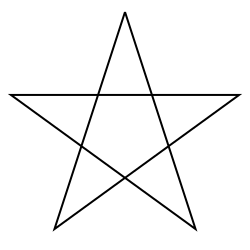 {5/2} |
| Regular (3D) polyhedra | |
| Convex | Star |
 {5,3} |  {5/2,5} |
| Regular 4D polytopes | |
| Convex | Star |
 {5,3,3} |  {5/2,5,3} |
| Regular 2D tessellations | |
| Euclidean | Hyperbolic |
 {4,4} |  {5,4} |
| Regular 3D tessellations | |
| Euclidean | Hyperbolic |
 {4,3,4} |  {5,3,4} |
This article lists the regular polytopes in Euclidean, spherical and hyperbolic spaces.
Overview
[edit]This table shows a summary of regular polytope counts by rank.
Rank | Finite | Euclidean | Hyperbolic | Abstract | |||||
|---|---|---|---|---|---|---|---|---|---|
| Compact | Paracompact | ||||||||
| Convex | Star | Skew[a][1] | Convex | Skew[a][1] | Convex | Star | Convex | ||
| 1 | 1 | none | none | none | none | none | none | none | 1 |
| 2 | ∞ | ∞ | none | 1 | none | 1 | none | none | ∞ |
| 3 | 5 | 4 | 9 | 3 | 3 | ∞ | ∞ | ∞ | ∞ |
| 4 | 6 | 10 | 18 | 1 | 7 | 4 | none | 11 | ∞ |
| 5 | 3 | none | 3 | 3 | 15 | 5 | 4 | 2 | ∞ |
| 6 | 3 | none | 3 | 1 | 7 | none | none | 5 | ∞ |
| 7+ | 3 | none | 3 | 1 | 7 | none | none | none | ∞ |
There are no Euclidean regular star tessellations in any number of dimensions.
1-polytopes
[edit] | A Coxeter diagram represent mirror "planes" as nodes, and puts a ring around a node if a point is not on the plane. A dion { }, |
There is only one polytope of rank 1 (1-polytope), the closed line segment bounded by its two endpoints. Every realization of this 1-polytope is regular. It has the Schläfli symbol { },[2][3] or a Coxeter diagram with a single ringed node, ![]() . Norman Johnson calls it a dion[4] and gives it the Schläfli symbol { }.
. Norman Johnson calls it a dion[4] and gives it the Schläfli symbol { }.
Although trivial as a polytope, it appears as the edges of polygons and other higher dimensional polytopes.[5] It is used in the definition of uniform prisms like Schläfli symbol { }×{p}, or Coxeter diagram ![]()
![]()
![]()
![]()
![]() as a Cartesian product of a line segment and a regular polygon.[6]
as a Cartesian product of a line segment and a regular polygon.[6]
2-polytopes (polygons)
[edit]The polytopes of rank 2 (2-polytopes) are called polygons. Regular polygons are equilateral and cyclic. A p-gonal regular polygon is represented by Schläfli symbol {p}.
Many sources only consider convex polygons, but star polygons, like the pentagram, when considered, can also be regular. They use the same vertices as the convex forms, but connect in an alternate connectivity which passes around the circle more than once to be completed.
Convex
[edit]The Schläfli symbol {p} represents a regular p-gon.
| Name | Triangle (2-simplex) | Square (2-orthoplex) (2-cube) | Pentagon (2-pentagonal polytope) | Hexagon | Heptagon | Octagon | |
|---|---|---|---|---|---|---|---|
| Schläfli | {3} | {4} | {5} | {6} | {7} | {8} | |
| Symmetry | D3, [3] | D4, [4] | D5, [5] | D6, [6] | D7, [7] | D8, [8] | |
| Coxeter | |||||||
| Image |  |  |  |  |  |  | |
| Name | Nonagon (Enneagon) | Decagon | Hendecagon | Dodecagon | Tridecagon | Tetradecagon | |
| Schläfli | {9} | {10} | {11} | {12} | {13} | {14} | |
| Symmetry | D9, [9] | D10, [10] | D11, [11] | D12, [12] | D13, [13] | D14, [14] | |
| Dynkin | |||||||
| Image |  |  |  |  |  |  | |
| Name | Pentadecagon | Hexadecagon | Heptadecagon | Octadecagon | Enneadecagon | Icosagon | p-gon |
| Schläfli | {15} | {16} | {17} | {18} | {19} | {20} | {p} |
| Symmetry | D15, [15] | D16, [16] | D17, [17] | D18, [18] | D19, [19] | D20, [20] | Dp, [p] |
| Dynkin | |||||||
| Image |  |  |  |  |  |  |  |
Spherical
[edit]The regular digon {2} can be considered to be a degenerate regular polygon. It can be realized non-degenerately in some non-Euclidean spaces, such as on the surface of a sphere or torus. For example, digon can be realised non-degenerately as a spherical lune. A monogon {1} could also be realised on the sphere as a single point with a great circle through it.[7] However, a monogon is not a valid abstract polytope because its single edge is incident to only one vertex rather than two.
| Name | Monogon | Digon |
|---|---|---|
| Schläfli symbol | {1} | {2} |
| Symmetry | D1, [ ] | D2, [2] |
| Coxeter diagram | ||
| Image |  |  |
Stars
[edit]There exist infinitely many regular star polytopes in two dimensions, whose Schläfli symbols consist of rational numbers {n/m}. They are called star polygons and share the same vertex arrangements of the convex regular polygons.
In general, for any natural number n, there are regular n-pointed stars with Schläfli symbols {n/m} for all m such that m < n/2 (strictly speaking {n/m} = {n/(n − m)}) and m and n are coprime (as such, all stellations of a polygon with a prime number of sides will be regular stars). Symbols where m and n are not coprime may be used to represent compound polygons.
| Name | Pentagram | Heptagrams | Octagram | Enneagrams | Decagram | ...n-grams | ||
|---|---|---|---|---|---|---|---|---|
| Schläfli | {5/2} | {7/2} | {7/3} | {8/3} | {9/2} | {9/4} | {10/3} | {p/q} |
| Symmetry | D5, [5] | D7, [7] | D8, [8] | D9, [9], | D10, [10] | Dp, [p] | ||
| Coxeter | ||||||||
| Image |  |  |  | 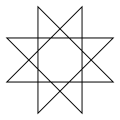 |  |  |  | |
Star polygons that can only exist as spherical tilings, similarly to the monogon and digon, may exist (for example: {3/2}, {5/3}, {5/4}, {7/4}, {9/5}), however these have not been studied in detail.
There also exist failed star polygons, such as the piangle, which do not cover the surface of a circle finitely many times.[8]
Skew polygons
[edit]In addition to the planar regular polygons there are infinitely many regular skew polygons. Skew polygons can be created via the blending operation.
The blend of two polygons P and Q, written P#Q, can be constructed as follows:
- take the cartesian product of their vertices VP × VQ.
- add edges (p0 × q0, p1 × q1) where (p0, p1) is an edge of P and (q0, q1) is an edge of Q.
- select an arbitrary connected component of the result.
Alternatively, the blend is the polygon ⟨ρ0σ0, ρ1σ1⟩ where ρ and σ are the generating mirrors of P and Q placed in orthogonal subspaces.[9] The blending operation is commutative, associative and idempotent.
Every regular skew polygon can be expressed as the blend of a unique[i] set of planar polygons.[9] If P and Q share no factors then Dim(P#Q) = Dim(P) + Dim(Q).
In 3 space
[edit]The regular finite polygons in 3 dimensions are exactly the blends of the planar polygons (dimension 2) with the digon (dimension 1). They have vertices corresponding to a prism ({n/m}#{} where n is odd) or an antiprism ({n/m}#{} where n is even). All polygons in 3 space have an even number of vertices and edges.
Several of these appear as the Petrie polygons of regular polyhedra.
In 4 space
[edit]The regular finite polygons in 4 dimensions are exactly the polygons formed as a blend of two distinct planar polygons. They have vertices lying on a Clifford torus and related by a Clifford displacement. Unlike 3-dimensional polygons, skew polygons on double rotations can include an odd-number of sides.
3-polytopes (polyhedra)
[edit]Polytopes of rank 3 are called polyhedra:
A regular polyhedron with Schläfli symbol {p, q}, Coxeter diagrams ![]()
![]()
![]()
![]()
![]() , has a regular face type {p}, and regular vertex figure {q}.
, has a regular face type {p}, and regular vertex figure {q}.
A vertex figure (of a polyhedron) is a polygon, seen by connecting those vertices which are one edge away from a given vertex. For regular polyhedra, this vertex figure is always a regular (and planar) polygon.
Existence of a regular polyhedron {p, q} is constrained by an inequality, related to the vertex figure's angle defect:
By enumerating the permutations, we find five convex forms, four star forms and three plane tilings, all with polygons {p} and {q} limited to: {3}, {4}, {5}, {5/2}, and {6}.
Beyond Euclidean space, there is an infinite set of regular hyperbolic tilings.
Convex
[edit]The five convex regular polyhedra are called the Platonic solids. The vertex figure is given with each vertex count. All these polyhedra have an Euler characteristic (χ) of 2.
| Name | Schläfli {p, q} | Coxeter | Image (solid) | Image (sphere) | Faces {p} | Edges | Vertices {q} | Symmetry | Dual |
|---|---|---|---|---|---|---|---|---|---|
| Tetrahedron (3-simplex) | {3,3} | 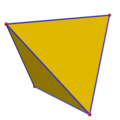 |  | 4 {3} | 6 | 4 {3} | Td [3,3] (*332) | (self) | |
| Hexahedron Cube (3-cube) | {4,3} |  |  | 6 {4} | 12 | 8 {3} | Oh [4,3] (*432) | Octahedron | |
| Octahedron (3-orthoplex) | {3,4} |  | 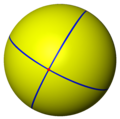 | 8 {3} | 12 | 6 {4} | Oh [4,3] (*432) | Cube | |
| Dodecahedron | {5,3} |  |  | 12 {5} | 30 | 20 {3} | Ih [5,3] (*532) | Icosahedron | |
| Icosahedron | {3,5} |  |  | 20 {3} | 30 | 12 {5} | Ih [5,3] (*532) | Dodecahedron |
Spherical
[edit]In spherical geometry, regular spherical polyhedra (tilings of the sphere) exist that would otherwise be degenerate as polytopes. These are the hosohedra {2,n} and their dual dihedra {n,2}. Coxeter calls these cases "improper" tessellations.[10]
The first few cases (n from 2 to 6) are listed below.
| Name | Schläfli {2,p} | Coxeter diagram | Image (sphere) | Faces {2}π/p | Edges | Vertices {p} | Symmetry | Dual |
|---|---|---|---|---|---|---|---|---|
| Digonal hosohedron | {2,2} |  | 2 {2}π/2 | 2 | 2 {2}π/2 | D2h [2,2] (*222) | Self | |
| Trigonal hosohedron | {2,3} | 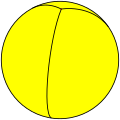 | 3 {2}π/3 | 3 | 2 {3} | D3h [2,3] (*322) | Trigonal dihedron | |
| Square hosohedron | {2,4} |  | 4 {2}π/4 | 4 | 2 {4} | D4h [2,4] (*422) | Square dihedron | |
| Pentagonal hosohedron | {2,5} |  | 5 {2}π/5 | 5 | 2 {5} | D5h [2,5] (*522) | Pentagonal dihedron | |
| Hexagonal hosohedron | {2,6} |  | 6 {2}π/6 | 6 | 2 {6} | D6h [2,6] (*622) | Hexagonal dihedron |
| Name | Schläfli {p,2} | Coxeter diagram | Image (sphere) | Faces {p} | Edges | Vertices {2} | Symmetry | Dual |
|---|---|---|---|---|---|---|---|---|
| Digonal dihedron | {2,2} |  | 2 {2}π/2 | 2 | 2 {2}π/2 | D2h [2,2] (*222) | Self | |
| Trigonal dihedron | {3,2} |  | 2 {3} | 3 | 3 {2}π/3 | D3h [3,2] (*322) | Trigonal hosohedron | |
| Square dihedron | {4,2} | 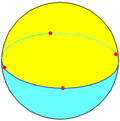 | 2 {4} | 4 | 4 {2}π/4 | D4h [4,2] (*422) | Square hosohedron | |
| Pentagonal dihedron | {5,2} |  | 2 {5} | 5 | 5 {2}π/5 | D5h [5,2] (*522) | Pentagonal hosohedron | |
| Hexagonal dihedron | {6,2} |  | 2 {6} | 6 | 6 {2}π/6 | D6h [6,2] (*622) | Hexagonal hosohedron |
Star-dihedra and hosohedra {p/q, 2} and {2, p/q} also exist for any star polygon {p/q}.
Stars
[edit]The regular star polyhedra are called the Kepler–Poinsot polyhedra and there are four of them, based on the vertex arrangements of the dodecahedron {5,3} and icosahedron {3,5}:
As spherical tilings, these star forms overlap the sphere multiple times, called its density, being 3 or 7 for these forms. The tiling images show a single spherical polygon face in yellow.
| Name | Image (skeletonic) | Image (solid) | Image (sphere) | Stellation diagram | Schläfli {p, q} and Coxeter | Faces {p} | Edges | Vertices {q} verf. | χ | Density | Symmetry | Dual |
|---|---|---|---|---|---|---|---|---|---|---|---|---|
| Small stellated dodecahedron |  |  |  |  | {5/2,5} | 12 {5/2} | 30 | 12 {5} | −6 | 3 | Ih [5,3] (*532) | Great dodecahedron |
| Great dodecahedron |  |  |  |  | {5,5/2} | 12 {5} | 30 | 12 {5/2} | −6 | 3 | Ih [5,3] (*532) | Small stellated dodecahedron |
| Great stellated dodecahedron |  |  |  |  | {5/2,3} | 12 {5/2} | 30 | 20 {3} | 2 | 7 | Ih [5,3] (*532) | Great icosahedron |
| Great icosahedron | 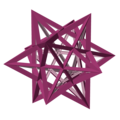 |  |  |  | {3,5/2} | 20 {3} | 30 | 12 {5/2} | 2 | 7 | Ih [5,3] (*532) | Great stellated dodecahedron |
There are infinitely many failed star polyhedra. These are also spherical tilings with star polygons in their Schläfli symbols, but they do not cover a sphere finitely many times. Some examples are {5/2,4}, {5/2,9}, {7/2,3}, {5/2,5/2}, {7/2,7/3}, {4,5/2}, and {3,7/3}.
Skew polyhedra
[edit]This section needs expansion. You can help by adding to it. (January 2024) |
Regular skew polyhedra are generalizations to the set of regular polyhedron which include the possibility of nonplanar vertex figures.
For 4-dimensional skew polyhedra, Coxeter offered a modified Schläfli symbol {l,m|n} for these figures, with {l,m} implying the vertex figure, m l-gons around a vertex, and n-gonal holes. Their vertex figures are skew polygons, zig-zagging between two planes.
The regular skew polyhedra, represented by {l,m|n}, follow this equation:
Four of them can be seen in 4-dimensions as a subset of faces of four regular 4-polytopes, sharing the same vertex arrangement and edge arrangement:
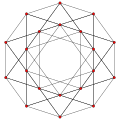 |  |  |  |
| {4, 6 | 3} | {6, 4 | 3} | {4, 8 | 3} | {8, 4 | 3} |
|---|
4-polytopes
[edit]Regular 4-polytopes with Schläfli symbol have cells of type , faces of type , edge figures , and vertex figures .
- A vertex figure (of a 4-polytope) is a polyhedron, seen by the arrangement of neighboring vertices around a given vertex. For regular 4-polytopes, this vertex figure is a regular polyhedron.
- An edge figure is a polygon, seen by the arrangement of faces around an edge. For regular 4-polytopes, this edge figure will always be a regular polygon.
The existence of a regular 4-polytope is constrained by the existence of the regular polyhedra . A suggested name for 4-polytopes is "polychoron".[11]
Each will exist in a space dependent upon this expression:
-
- : Hyperspherical 3-space honeycomb or 4-polytope
- : Euclidean 3-space honeycomb
- : Hyperbolic 3-space honeycomb
These constraints allow for 21 forms: 6 are convex, 10 are nonconvex, one is a Euclidean 3-space honeycomb, and 4 are hyperbolic honeycombs.
The Euler characteristic for convex 4-polytopes is zero:
Convex
[edit]The 6 convex regular 4-polytopes are shown in the table below. All these 4-polytopes have an Euler characteristic (χ) of 0.
| Name | Schläfli {p,q,r} | Coxeter | Cells {p,q} | Faces {p} | Edges {r} | Vertices {q,r} | Dual {r,q,p} |
|---|---|---|---|---|---|---|---|
| 5-cell (4-simplex) | {3,3,3} | 5 {3,3} | 10 {3} | 10 {3} | 5 {3,3} | (self) | |
| 8-cell (4-cube) (Tesseract) | {4,3,3} | 8 {4,3} | 24 {4} | 32 {3} | 16 {3,3} | 16-cell | |
| 16-cell (4-orthoplex) | {3,3,4} | 16 {3,3} | 32 {3} | 24 {4} | 8 {3,4} | Tesseract | |
| 24-cell | {3,4,3} | 24 {3,4} | 96 {3} | 96 {3} | 24 {4,3} | (self) | |
| 120-cell | {5,3,3} | 120 {5,3} | 720 {5} | 1200 {3} | 600 {3,3} | 600-cell | |
| 600-cell | {3,3,5} | 600 {3,3} | 1200 {3} | 720 {5} | 120 {3,5} | 120-cell |
| 5-cell | 8-cell | 16-cell | 24-cell | 120-cell | 600-cell |
|---|---|---|---|---|---|
| {3,3,3} | {4,3,3} | {3,3,4} | {3,4,3} | {5,3,3} | {3,3,5} |
| Wireframe (Petrie polygon) skew orthographic projections | |||||
 |  |  |  | 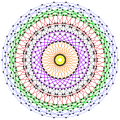 |  |
| Solid orthographic projections | |||||
 tetrahedral envelope (cell/ vertex-centered) | 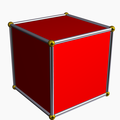 cubic envelope (cell-centered) |  cubic envelope (cell-centered) |  cuboctahedral envelope (cell-centered) |  truncated rhombic triacontahedron envelope (cell-centered) |  Pentakis icosidodecahedral envelope (vertex-centered) |
| Wireframe Schlegel diagrams (Perspective projection) | |||||
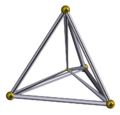 (cell-centered) | 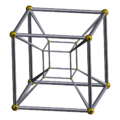 (cell-centered) | 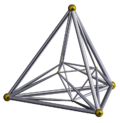 (cell-centered) |  (cell-centered) |  (cell-centered) |  (vertex-centered) |
| Wireframe stereographic projections (Hyperspherical) | |||||
 |  |  | 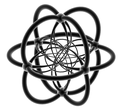 |  |  |
Spherical
[edit]Di-4-topes and hoso-4-topes exist as regular tessellations of the 3-sphere.
Regular di-4-topes (2 facets) include: {3,3,2}, {3,4,2}, {4,3,2}, {5,3,2}, {3,5,2}, {p,2,2}, and their hoso-4-tope duals (2 vertices): {2,3,3}, {2,4,3}, {2,3,4}, {2,3,5}, {2,5,3}, {2,2,p}. 4-polytopes of the form {2,p,2} are the same as {2,2,p}. There are also the cases {p,2,q} which have dihedral cells and hosohedral vertex figures.
| Schläfli {2,p,q} | Coxeter | Cells {2,p}π/q | Faces {2}π/p,π/q | Edges | Vertices | Vertex figure {p,q} | Symmetry | Dual |
|---|---|---|---|---|---|---|---|---|
| {2,3,3} | 4 {2,3}π/3  | 6 {2}π/3,π/3 | 4 | 2 | {3,3} | [2,3,3] | {3,3,2} | |
| {2,4,3} | 6 {2,4}π/3  | 12 {2}π/4,π/3 | 8 | 2 | {4,3} | [2,4,3] | {3,4,2} | |
| {2,3,4} | 8 {2,3}π/4  | 12 {2}π/3,π/4 | 6 | 2 | {3,4} | [2,4,3] | {4,3,2} | |
| {2,5,3} | 12 {2,5}π/3  | 30 {2}π/5,π/3 | 20 | 2 | {5,3} | [2,5,3] | {3,5,2} | |
| {2,3,5} | 20 {2,3}π/5  | 30 {2}π/3,π/5 | 12 | 2 | {3,5} | [2,5,3] | {5,3,2} |
Stars
[edit]There are ten regular star 4-polytopes, which are called the Schläfli–Hess 4-polytopes. Their vertices are based on the convex 120-cell {5,3,3} and 600-cell {3,3,5}.
Ludwig Schläfli found four of them and skipped the last six because he would not allow forms that failed the Euler characteristic on cells or vertex figures (for zero-hole tori: F+V−E=2). Edmund Hess (1843–1903) completed the full list of ten in his German book Einleitung in die Lehre von der Kugelteilung mit besonderer Berücksichtigung ihrer Anwendung auf die Theorie der Gleichflächigen und der gleicheckigen Polyeder (1883)[1].
There are 4 unique edge arrangements and 7 unique face arrangements from these 10 regular star 4-polytopes, shown as orthogonal projections:
| Name | Wireframe | Solid | Schläfli {p, q, r} Coxeter | Cells {p, q} | Faces {p} | Edges {r} | Vertices {q, r} | Density | χ | Symmetry group | Dual {r, q,p} |
|---|---|---|---|---|---|---|---|---|---|---|---|
| Icosahedral 120-cell (faceted 600-cell) |  |  | {3,5,5/2} | 120 {3,5} | 1200 {3} | 720 {5/2} | 120 {5,5/2} | 4 | 480 | H4 [5,3,3] | Small stellated 120-cell |
| Small stellated 120-cell |  |  | {5/2,5,3} | 120 {5/2,5} | 720 {5/2} | 1200 {3} | 120 {5,3} | 4 | −480 | H4 [5,3,3] | Icosahedral 120-cell |
| Great 120-cell |  |  | {5,5/2,5} | 120 {5,5/2} | 720 {5} | 720 {5} | 120 {5/2,5} | 6 | 0 | H4 [5,3,3] | Self-dual |
| Grand 120-cell |  |  | {5,3,5/2} | 120 {5,3} | 720 {5} | 720 {5/2} | 120 {3,5/2} | 20 | 0 | H4 [5,3,3] | Great stellated 120-cell |
| Great stellated 120-cell |  |  | {5/2,3,5} | 120 {5/2,3} | 720 {5/2} | 720 {5} | 120 {3,5} | 20 | 0 | H4 [5,3,3] | Grand 120-cell |
| Grand stellated 120-cell |  |  | {5/2,5,5/2} | 120 {5/2,5} | 720 {5/2} | 720 {5/2} | 120 {5,5/2} | 66 | 0 | H4 [5,3,3] | Self-dual |
| Great grand 120-cell |  |  | {5,5/2,3} | 120 {5,5/2} | 720 {5} | 1200 {3} | 120 {5/2,3} | 76 | −480 | H4 [5,3,3] | Great icosahedral 120-cell |
| Great icosahedral 120-cell (great faceted 600-cell) |  |  | {3,5/2,5} | 120 {3,5/2} | 1200 {3} | 720 {5} | 120 {5/2,5} | 76 | 480 | H4 [5,3,3] | Great grand 120-cell |
| Grand 600-cell |  |  | {3,3,5/2} | 600 {3,3} | 1200 {3} | 720 {5/2} | 120 {3,5/2} | 191 | 0 | H4 [5,3,3] | Great grand stellated 120-cell |
| Great grand stellated 120-cell |  |  | {5/2,3,3} | 120 {5/2,3} | 720 {5/2} | 1200 {3} | 600 {3,3} | 191 | 0 | H4 [5,3,3] | Grand 600-cell |
There are 4 failed potential regular star 4-polytopes permutations: {3,5/2,3}, {4,3,5/2}, {5/2,3,4}, {5/2,3,5/2}. Their cells and vertex figures exist, but they do not cover a hypersphere with a finite number of repetitions.
Skew 4-polytopes
[edit]This section needs expansion. You can help by adding to it. (January 2024) |
In addition to the 16 planar 4-polytopes above there are 18 finite skew polytopes.[12] One of these is obtained as the Petrial of the tesseract, and the other 17 can be formed by applying the kappa operation to the planar polytopes and the Petrial of the tesseract.
Ranks 5 and higher
[edit]5-polytopes can be given the symbol where is the 4-face type, is the cell type, is the face type, and is the face figure, is the edge figure, and is the vertex figure.
- A vertex figure (of a 5-polytope) is a 4-polytope, seen by the arrangement of neighboring vertices to each vertex.
- An edge figure (of a 5-polytope) is a polyhedron, seen by the arrangement of faces around each edge.
- A face figure (of a 5-polytope) is a polygon, seen by the arrangement of cells around each face.
A regular 5-polytope exists only if and are regular 4-polytopes.
The space it fits in is based on the expression:
-
- : Spherical 4-space tessellation or 5-space polytope
- : Euclidean 4-space tessellation
- : hyperbolic 4-space tessellation
Enumeration of these constraints produce 3 convex polytopes, no star polytopes, 3 tessellations of Euclidean 4-space, and 5 tessellations of paracompact hyperbolic 4-space. The only non-convex regular polytopes for ranks 5 and higher are skews.
Convex
[edit]In dimensions 5 and higher, there are only three kinds of convex regular polytopes.[13]
| Name | Schläfli Symbol {p1,...,pn−1} | Coxeter | k-faces | Facet type | Vertex figure | Dual |
|---|---|---|---|---|---|---|
| n-simplex | {3n−1} | {3n−2} | {3n−2} | Self-dual | ||
| n-cube | {4,3n−2} | {4,3n−3} | {3n−2} | n-orthoplex | ||
| n-orthoplex | {3n−2,4} | {3n−2} | {3n−3,4} | n-cube |
There are also improper cases where some numbers in the Schläfli symbol are 2. For example, {p,q,r,...2} is an improper regular spherical polytope whenever {p,q,r...} is a regular spherical polytope, and {2,...p,q,r} is an improper regular spherical polytope whenever {...p,q,r} is a regular spherical polytope. Such polytopes may also be used as facets, yielding forms such as {p,q,...2...y,z}.
5 dimensions
[edit]| Name | Schläfli Symbol {p,q,r,s} Coxeter | Facets {p,q,r} | Cells {p,q} | Faces {p} | Edges | Vertices | Face figure {s} | Edge figure {r,s} | Vertex figure {q,r,s} |
|---|---|---|---|---|---|---|---|---|---|
| 5-simplex | {3,3,3,3} | 6 {3,3,3} | 15 {3,3} | 20 {3} | 15 | 6 | {3} | {3,3} | {3,3,3} |
| 5-cube | {4,3,3,3} | 10 {4,3,3} | 40 {4,3} | 80 {4} | 80 | 32 | {3} | {3,3} | {3,3,3} |
| 5-orthoplex | {3,3,3,4} | 32 {3,3,3} | 80 {3,3} | 80 {3} | 40 | 10 | {4} | {3,4} | {3,3,4} |
 5-simplex |  5-cube |  5-orthoplex |
6 dimensions
[edit]| Name | Schläfli | Vertices | Edges | Faces | Cells | 4-faces | 5-faces | χ |
|---|---|---|---|---|---|---|---|---|
| 6-simplex | {3,3,3,3,3} | 7 | 21 | 35 | 35 | 21 | 7 | 0 |
| 6-cube | {4,3,3,3,3} | 64 | 192 | 240 | 160 | 60 | 12 | 0 |
| 6-orthoplex | {3,3,3,3,4} | 12 | 60 | 160 | 240 | 192 | 64 | 0 |
 6-simplex |  6-cube |  6-orthoplex |
7 dimensions
[edit]| Name | Schläfli | Vertices | Edges | Faces | Cells | 4-faces | 5-faces | 6-faces | χ |
|---|---|---|---|---|---|---|---|---|---|
| 7-simplex | {3,3,3,3,3,3} | 8 | 28 | 56 | 70 | 56 | 28 | 8 | 2 |
| 7-cube | {4,3,3,3,3,3} | 128 | 448 | 672 | 560 | 280 | 84 | 14 | 2 |
| 7-orthoplex | {3,3,3,3,3,4} | 14 | 84 | 280 | 560 | 672 | 448 | 128 | 2 |
 7-simplex |  7-cube |  7-orthoplex |
8 dimensions
[edit]| Name | Schläfli | Vertices | Edges | Faces | Cells | 4-faces | 5-faces | 6-faces | 7-faces | χ |
|---|---|---|---|---|---|---|---|---|---|---|
| 8-simplex | {3,3,3,3,3,3,3} | 9 | 36 | 84 | 126 | 126 | 84 | 36 | 9 | 0 |
| 8-cube | {4,3,3,3,3,3,3} | 256 | 1024 | 1792 | 1792 | 1120 | 448 | 112 | 16 | 0 |
| 8-orthoplex | {3,3,3,3,3,3,4} | 16 | 112 | 448 | 1120 | 1792 | 1792 | 1024 | 256 | 0 |
 8-simplex |  8-cube |  8-orthoplex |
9 dimensions
[edit]| Name | Schläfli | Vertices | Edges | Faces | Cells | 4-faces | 5-faces | 6-faces | 7-faces | 8-faces | χ |
|---|---|---|---|---|---|---|---|---|---|---|---|
| 9-simplex | {38} | 10 | 45 | 120 | 210 | 252 | 210 | 120 | 45 | 10 | 2 |
| 9-cube | {4,37} | 512 | 2304 | 4608 | 5376 | 4032 | 2016 | 672 | 144 | 18 | 2 |
| 9-orthoplex | {37,4} | 18 | 144 | 672 | 2016 | 4032 | 5376 | 4608 | 2304 | 512 | 2 |
 9-simplex |  9-cube |  9-orthoplex |
10 dimensions
[edit]| Name | Schläfli | Vertices | Edges | Faces | Cells | 4-faces | 5-faces | 6-faces | 7-faces | 8-faces | 9-faces | χ |
|---|---|---|---|---|---|---|---|---|---|---|---|---|
| 10-simplex | {39} | 11 | 55 | 165 | 330 | 462 | 462 | 330 | 165 | 55 | 11 | 0 |
| 10-cube | {4,38} | 1024 | 5120 | 11520 | 15360 | 13440 | 8064 | 3360 | 960 | 180 | 20 | 0 |
| 10-orthoplex | {38,4} | 20 | 180 | 960 | 3360 | 8064 | 13440 | 15360 | 11520 | 5120 | 1024 | 0 |
 10-simplex |  10-cube |  10-orthoplex |
Star polytopes
[edit]There are no regular star polytopes of rank 5 or higher, with the exception of degenerate polytopes created by the star product of lower rank star polytopes. e.g. hosotopes and ditopes.
Regular projective polytopes
[edit]A projective regular (n+1)-polytope exists when an original regular n-spherical tessellation, {p,q,...}, is centrally symmetric. Such a polytope is named hemi-{p,q,...}, and contain half as many elements. Coxeter gives a symbol {p,q,...}/2, while McMullen writes {p,q,...}h/2 with h as the coxeter number.[14]
Even-sided regular polygons have hemi-2n-gon projective polygons, {2p}/2.
There are 4 regular projective polyhedra related to 4 of 5 Platonic solids.
The hemi-cube and hemi-octahedron generalize as hemi-n-cubes and hemi-n-orthoplexes to any rank.
Regular projective polyhedra
[edit]| Name | Coxeter McMullen | Image | Faces | Edges | Vertices | χ | skeleton graph |
|---|---|---|---|---|---|---|---|
| Hemi-cube | {4,3}/2 {4,3}3 |  | 3 | 6 | 4 | 1 | K4 |
| Hemi-octahedron | {3,4}/2 {3,4}3 |  | 4 | 6 | 3 | 1 | Double-edged K3 |
| Hemi-dodecahedron | {5,3}/2 {5,3}5 |  | 6 | 15 | 10 | 1 | G(5,2) |
| Hemi-icosahedron | {3,5}/2 {3,5}5 |  | 10 | 15 | 6 | 1 | K6 |
Regular projective 4-polytopes
[edit]5 of 6 convex regular 4-polytopes are centrally symmetric generating projective 4-polytopes. The 3 special cases are hemi-24-cell, hemi-600-cell, and hemi-120-cell.
| Name | Coxeter symbol | McMullen Symbol | Cells | Faces | Edges | Vertices | χ | Skeleton graph |
|---|---|---|---|---|---|---|---|---|
| Hemitesseract | {4,3,3}/2 | {4,3,3}4 | 4 | 12 | 16 | 8 | 0 | K4,4 |
| Hemi-16-cell | {3,3,4}/2 | {3,3,4}4 | 8 | 16 | 12 | 4 | 0 | double-edged K4 |
| Hemi-24-cell | {3,4,3}/2 | {3,4,3}6 | 12 | 48 | 48 | 12 | 0 | |
| Hemi-120-cell | {5,3,3}/2 | {5,3,3}15 | 60 | 360 | 600 | 300 | 0 | |
| Hemi-600-cell | {3,3,5}/2 | {3,3,5}15 | 300 | 600 | 360 | 60 | 0 |
Regular projective 5-polytopes
[edit]Only 2 of 3 regular spherical polytopes are centrally symmetric for ranks 5 or higher. The corresponding regular projective polytopes are the hemi versions of the regular hypercube and orthoplex. They are tabulated below for rank 5, for example:
| Name | Schläfli | 4-faces | Cells | Faces | Edges | Vertices | χ | Skeleton graph |
|---|---|---|---|---|---|---|---|---|
| hemi-penteract | {4,3,3,3}/2 | 5 | 20 | 40 | 40 | 16 | 1 | Tesseract skeleton + 8 central diagonals |
| hemi-pentacross | {3,3,3,4}/2 | 16 | 40 | 40 | 20 | 5 | 1 | double-edged K5 |
Apeirotopes
[edit]An apeirotope or infinite polytope is a polytope which has infinitely many facets. An n-apeirotope is an infinite n-polytope: a 2-apeirotope or apeirogon is an infinite polygon, a 3-apeirotope or apeirohedron is an infinite polyhedron, etc.
There are two main geometric classes of apeirotope:[15]
- Regular honeycombs in n dimensions, which completely fill an n-dimensional space.
- Regular skew apeirotopes, comprising an n-dimensional manifold in a higher space.
2-apeirotopes (apeirogons)
[edit]The straight apeirogon is a regular tessellation of the line, subdividing it into infinitely many equal segments. It has infinitely many vertices and edges. Its Schläfli symbol is {∞}, and Coxeter diagram ![]()
![]()
![]() .
.
It exists as the limit of the p-gon as p tends to infinity, as follows:
| Name | Monogon | Digon | Triangle | Square | Pentagon | Hexagon | Heptagon | p-gon | Apeirogon |
|---|---|---|---|---|---|---|---|---|---|
| Schläfli | {1} | {2} | {3} | {4} | {5} | {6} | {7} | {p} | {∞} |
| Symmetry | D1, [ ] | D2, [2] | D3, [3] | D4, [4] | D5, [5] | D6, [6] | D7, [7] | [p] | |
| Coxeter | |||||||||
| Image |  |  |  |  |  |  |  |
Apeirogons in the hyperbolic plane, most notably the regular apeirogon, {∞}, can have a curvature just like finite polygons of the Euclidean plane, with the vertices circumscribed by horocycles or hypercycles rather than circles.
Regular apeirogons that are scaled to converge at infinity have the symbol {∞} and exist on horocycles, while more generally they can exist on hypercycles.
| {∞} | {iπ/λ} |
|---|---|
 Apeirogon on horocycle |  Apeirogon on hypercycle |
Above are two regular hyperbolic apeirogons in the Poincaré disk model, the right one shows perpendicular reflection lines of divergent fundamental domains, separated by length λ.
Skew apeirogons
[edit]A skew apeirogon in two dimensions forms a zig-zag line in the plane. If the zig-zag is even and symmetrical, then the apeirogon is regular.
Skew apeirogons can be constructed in any number of dimensions. In three dimensions, a regular skew apeirogon traces out a helical spiral and may be either left- or right-handed.
| 2 dimensions | 3 dimensions |
|---|---|
 Zig-zag apeirogon |  Helix apeirogon |
3-apeirotopes (apeirohedra)
[edit]Euclidean tilings
[edit]There are six regular tessellations of the plane: the three listed below, and their corresponding Petrials.
| Name | Square tiling (quadrille) | Triangular tiling (deltille) | Hexagonal tiling (hextille) |
|---|---|---|---|
| Symmetry | p4m, [4,4], (*442) | p6m, [6,3], (*632) | |
| Schläfli {p,q} | {4,4} | {3,6} | {6,3} |
| Coxeter diagram | |||
| Image |  |  | 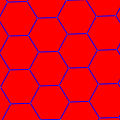 |
There are two improper regular tilings: {∞,2}, an apeirogonal dihedron, made from two apeirogons, each filling half the plane; and secondly, its dual, {2,∞}, an apeirogonal hosohedron, seen as an infinite set of parallel lines.
 {∞,2}, |  {2,∞}, |
Euclidean star-tilings
[edit]There are no regular plane tilings of star polygons. There are many enumerations that fit in the plane (1/p + 1/q = 1/2), like {8/3,8}, {10/3,5}, {5/2,10}, {12/5,12}, etc., but none repeat periodically.
Hyperbolic tilings
[edit]Tessellations of hyperbolic 2-space are hyperbolic tilings. There are infinitely many regular tilings in H2. As stated above, every positive integer pair {p,q} such that 1/p + 1/q < 1/2 gives a hyperbolic tiling. In fact, for the general Schwarz triangle (p, q, r) the same holds true for 1/p + 1/q + 1/r < 1.
There are a number of different ways to display the hyperbolic plane, including the Poincaré disk model which maps the plane into a circle, as shown below. It should be recognized that all of the polygon faces in the tilings below are equal-sized and only appear to get smaller near the edges due to the projection applied, very similar to the effect of a camera fisheye lens.
There are infinitely many flat regular 3-apeirotopes (apeirohedra) as regular tilings of the hyperbolic plane, of the form {p,q}, with p+q<pq/2.
- {3,7}, {3,8}, {3,9} ... {3,∞}
- {4,5}, {4,6}, {4,7} ... {4,∞}
- {5,4}, {5,5}, {5,6} ... {5,∞}
- {6,4}, {6,5}, {6,6} ... {6,∞}
- {7,3}, {7,4}, {7,5} ... {7,∞}
- {8,3}, {8,4}, {8,5} ... {8,∞}
- {9,3}, {9,4}, {9,5} ... {9,∞}
- ...
- {∞,3}, {∞,4}, {∞,5} ... {∞,∞}
A sampling:
| Regular hyperbolic tiling table | |||||||||||
|---|---|---|---|---|---|---|---|---|---|---|---|
| Spherical (improper/Platonic)/Euclidean/hyperbolic (Poincaré disk: compact/paracompact/noncompact) tessellations with their Schläfli symbol | |||||||||||
| p \ q | 2 | 3 | 4 | 5 | 6 | 7 | 8 | ... | ∞ | ... | iπ/λ |
| 2 |  {2,2} |  {2,3} |  {2,4} |  {2,5} |  {2,6} |  {2,7} |  {2,8} |  {2,∞} |  {2,iπ/λ} | ||
| 3 |  {3,2} |  (tetrahedron) {3,3} |  (octahedron) {3,4} |  (icosahedron) {3,5} |  (deltille) {3,6} |  {3,7} |  {3,8} |  {3,∞} |  {3,iπ/λ} | ||
| 4 |  {4,2} |  (cube) {4,3} |  (quadrille) {4,4} |  {4,5} |  {4,6} |  {4,7} |  {4,8} |  {4,∞} |  {4,iπ/λ} | ||
| 5 |  {5,2} |  (dodecahedron) {5,3} |  {5,4} |  {5,5} |  {5,6} |  {5,7} |  {5,8} |  {5,∞} |  {5,iπ/λ} | ||
| 6 |  {6,2} |  (hextille) {6,3} |  {6,4} |  {6,5} |  {6,6} |  {6,7} |  {6,8} |  {6,∞} |  {6,iπ/λ} | ||
| 7 | {7,2} |  {7,3} |  {7,4} |  {7,5} |  {7,6} |  {7,7} | {7,8} |  {7,∞} | {7,iπ/λ} | ||
| 8 | {8,2} |  {8,3} |  {8,4} |  {8,5} |  {8,6} |  {8,7} |  {8,8} |  {8,∞} | {8,iπ/λ} | ||
| ... | |||||||||||
| ∞ |  {∞,2} |  {∞,3} |
| ||||||||






































![{\displaystyle {\begin{aligned}&{\frac {1}{p}}+{\frac {1}{q}}>{\frac {1}{2}}:{\text{Polyhedron (existing in Euclidean 3-space)}}\\[6pt]&{\frac {1}{p}}+{\frac {1}{q}}={\frac {1}{2}}:{\text{Euclidean plane tiling}}\\[6pt]&{\frac {1}{p}}+{\frac {1}{q}}<{\frac {1}{2}}:{\text{Hyperbolic plane tiling}}\end{aligned}}}](https://wikimedia.org/api/rest_v1/media/math/render/svg/8b3e3112344f5e050eb160928c5170cabb51bcf8)























